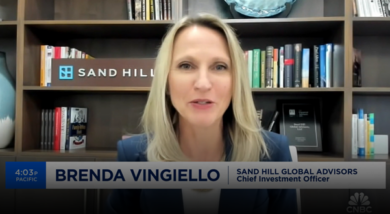Brenda Vingiello, Sand Hill's Chief Investment Officer, joined the Halftime Report to discuss the software space. This content was produced and provided by an unaffiliated

Living in the Age of Uncomfortable Change
November 2, 2021
During the last several decades, the world benefitted from considerable positive change as the advent of the internet, smart phones, and immunotherapies—to name a few—altered the way we did things and made our lives easier. Ironically, this may have contributed to making the last two pandemic-impacted years feel so unsettling. If there is one theme that could characterize this relatively short period, it would be uncomfortable change. Even though this current environment will likely have multiple silver-lining outcomes—from better work-life balance, to increased ability to rapidly create life-saving medical therapies and vaccines, and less general reliance on fossil fuels—the initial stage to get to that improved end-result has been anything but easy.
When the pandemic began, we were forced to change the way we lived our lives by dramatically limiting our social interactions, wearing masks—which is not common in Western culture—and, ironically, adopting the latest technology whether we were ready to or not. This tension was compounded because many people made life and career altering choices that were driven by rather extreme concern for their own health and that of their family; and companies made tough, long-term decisions as the pandemic-driven disruption dragged on.
When 2021 began, we were all longing for the day when things would be back to normal. As we assess the environment today, we have a lot to be thankful for as vaccines have changed the course of the pandemic, the stock market has rebounded and reached new record highs, and more flexible work arrangements are here to stay. These could absolutely be categorized as an improvement to the “old normal”. Yet not everything has returned to the way it used to be. In fact, some things seem to have gotten worse over time. Ongoing supply chain disruptions have led to shortages and higher shipping costs, and supply/demand imbalances within many parts of the commodity complex are also contributing to inflationary pressures. While some of this inflation will likely be transitory, the timing of such price increases returning to pre-pandemic levels remains uncertain.
In our view, supply-chain-driven price increases are likely to prove temporary, although they may persist for several more quarters. Last year, stronger than expected demand for goods took global supply chains by surprise, and they were already grappling with pandemic-driven labor shortages and port shutdowns. Even as the economy began to slowly reopen, demand for goods stayed high. According to BCA Research, spending on consumer durable goods was 27% above pre-pandemic levels in March of this year. By August, it had declined, but it was still 8% higher than its normal trend. Supply chains have remained strained, and the Delta variant led to another round of turmoil at ports and factories around the world. With the Federal government stepping in to try to help ease congestion at the nation’s busiest ports, there is some hope that this impact will subside over time. Yet, the complexity and trickle-down effects of the disruption will be difficult to remedy quickly. Nevertheless, we expect financial markets will likely react favorably to news that this gridlock is at least beginning to dissipate, even if it does take a long time to return to pre-pandemic levels.
Disruptions taking place within the commodity industry are trickier to solve and could cause price volatility for some time to come. Prior to the pandemic, much of the fossil fuel industry was suffering from a lack of investment, particularly following the oil price decline that took place in 2015. This lack of capital has been coupled with the variety of competing company stakeholders that management teams now answer to, including activist shareholders and board members that have been dissuading companies from investing in further production in favor of developing more renewable energy capacity. By many measures, this is all a necessary transition, but the complexities of managing the global supply of fossil fuel are starkly coming to the forefront as this transition evolves.
In addition, during the height of the pandemic, inventories of many commodities rose significantly as economic activity declined. This further discouraged companies from investing in growing production. As the world has reopened and demand has increased, these inventories have now been depleted, making various industries more susceptible to even modest disruptions. Yet, we are now in a global environment where the adage that the cure for higher commodity prices is higher commodity prices may no longer ring true as companies and boards are more focused on shifting production to renewable energy sources. This has the potential to result in a period of prolonged supply/demand imbalances that may not be as temporary as we would like them to be. The International Energy Agency (IEA) estimates that renewable energy sources will generate 20% of global energy production by 2030, up from 12% in 2020. However, the IEA also forecasts that by that time the global economy will still need about 5% more oil and natural gas than it consumes today.
This environment has given us greater conviction in the overweight position in commodities that we established for our clients over the last year. When we first added to commodities in April of 2020, it was an unpopular investment. Yet, we felt that markets would normalize and that forward oil prices—which were astonishingly negative at the time—would likely recover. We also recognized that under-investment in the fossil fuel industry would likely result in a favorable supply/demand environment when the global economy began to reopen. Furthermore, the global shift to renewable energy also supports an increase in demand for industrial metals that are needed to build out the necessary new infrastructure.
Even though rising prices represent another uncomfortable change, the pieces may be in place for the global economy to manage through this period. Corporate profitability is at an all-time high, which suggests that companies could manage through a higher interest rate environment that is driven by an improving economy and modestly higher inflation. Furthermore, many of the largest companies in the S&P 500 have significant pricing power and would likely be able to pass higher prices along to their customers. Consumers’ balance sheets are also very healthy as savings are high, debt payments are low (as a percentage of income), and wage growth is increasing. All these factors should, in our view, help consumers manage through a period of higher-than-usual inflation. As usual, though, we are closely monitoring this evolving environment and plan to make changes to our clients’ portfolios to protect and grow capital should we feel it is warranted.
Articles and Commentary
Information provided in written articles are for informational purposes only and should not be considered investment advice. There is a risk of loss from investments in securities, including the risk of loss of principal. The information contained herein reflects Sand Hill Global Advisors' (“SHGA”) views as of the date of publication. Such views are subject to change at any time without notice due to changes in market or economic conditions and may not necessarily come to pass. SHGA does not provide tax or legal advice. To the extent that any material herein concerns tax or legal matters, such information is not intended to be solely relied upon nor used for the purpose of making tax and/or legal decisions without first seeking independent advice from a tax and/or legal professional. SHGA has obtained the information provided herein from various third party sources believed to be reliable but such information is not guaranteed. Certain links in this site connect to other websites maintained by third parties over whom SHGA has no control. SHGA makes no representations as to the accuracy or any other aspect of information contained in other Web Sites. Any forward looking statements or forecasts are based on assumptions and actual results are expected to vary from any such statements or forecasts. No reliance should be placed on any such statements or forecasts when making any investment decision. SHGA is not responsible for the consequences of any decisions or actions taken as a result of information provided in this presentation and does not warrant or guarantee the accuracy or completeness of this information. No part of this material may be (i) copied, photocopied, or duplicated in any form, by any means, or (ii) redistributed without the prior written consent of SHGA.
Video Presentations
All video presentations discuss certain investment products and/or securities and are being provided for informational purposes only, and should not be considered, and is not, investment, financial planning, tax or legal advice; nor is it a recommendation to buy or sell any securities. Investing in securities involves varying degrees of risk, and there can be no assurance that any specific investment will be profitable or suitable for a particular client’s financial situation or risk tolerance. Past performance is not a guarantee of future returns. Individual performance results will vary. The opinions expressed in the video reflect Sand Hill Global Advisor’s (“SHGA”) or Brenda Vingiello’s (as applicable) views as of the date of the video. Such views are subject to change at any point without notice. Any comments, opinions, or recommendations made by any host or other guest not affiliated with SHGA in this video do not necessarily reflect the views of SHGA, and non-SHGA persons appearing in this video do not fall under the supervisory purview of SHGA. You should not treat any opinion expressed by SHGA or Ms. Vingiello as a specific inducement to make a particular investment or follow a particular strategy, but only as an expression of general opinion. Nothing presented herein is or is intended to constitute investment advice, and no investment decision should be made based solely on any information provided on this video. There is a risk of loss from an investment in securities, including the risk of loss of principal. Neither SHGA nor Ms. Vingiello guarantees any specific outcome or profit. Any forward-looking statements or forecasts contained in the video are based on assumptions and actual results may vary from any such statements or forecasts. SHGA or one of its employees may have a position in the securities discussed and may purchase or sell such securities from time to time. Some of the information in this video has been obtained from third party sources. While SHGA believes such third-party information is reliable, SHGA does not guarantee its accuracy, timeliness or completeness. SHGA encourages you to consult with a professional financial advisor prior to making any investment decision.







